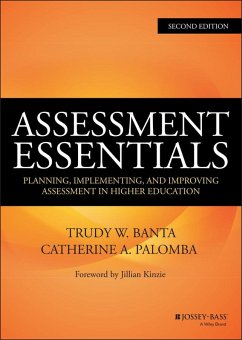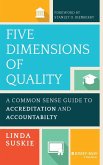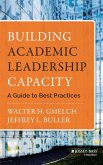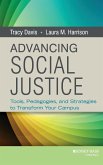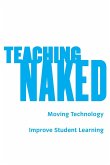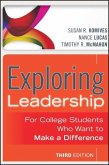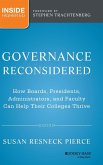Trudy W. Banta, Catherine A. PalombaPlanning, Implementing, and Improving Assessment in Higher Education
Assessment Essentials
Planning, Implementing, and Improving Assessment in Higher Education
Mitarbeit: Kinzie, Jillian
Trudy W. Banta, Catherine A. PalombaPlanning, Implementing, and Improving Assessment in Higher Education
Assessment Essentials
Planning, Implementing, and Improving Assessment in Higher Education
Mitarbeit: Kinzie, Jillian
- Gebundenes Buch
- Merkliste
- Auf die Merkliste
- Bewerten Bewerten
- Teilen
- Produkt teilen
- Produkterinnerung
- Produkterinnerung
A comprehensive expansion to the essential higher education assessment text This second edition of Assessment Essentials updates the bestselling first edition, the go-to resource on outcomes assessment in higher education. In this thoroughly revised edition, you will find, in a familiar framework, nearly all new material, examples from more than 100 campuses, and indispensable descriptions of direct and indirect assessment methods that have helped to educate faculty, staff, and students about assessment.
Outcomes assessment is of increasing importance in higher education, especially as new…mehr
Andere Kunden interessierten sich auch für
![Five Dimensions of Quality Five Dimensions of Quality]() Linda SuskieFive Dimensions of Quality55,99 €
Linda SuskieFive Dimensions of Quality55,99 €![Building Academic Leadership Capacity Building Academic Leadership Capacity]() Walter H. GmelchBuilding Academic Leadership Capacity52,99 €
Walter H. GmelchBuilding Academic Leadership Capacity52,99 €![Advancing Social Justice Advancing Social Justice]() Tracy DavisAdvancing Social Justice52,99 €
Tracy DavisAdvancing Social Justice52,99 €![Teaching Naked Teaching Naked]() José Antonio BowenTeaching Naked27,99 €
José Antonio BowenTeaching Naked27,99 €![The Essential Department Chair The Essential Department Chair]() Jeffrey BullerThe Essential Department Chair55,99 €
Jeffrey BullerThe Essential Department Chair55,99 €![Exploring Leadership with Access Code Exploring Leadership with Access Code]() Susan R. KomivesExploring Leadership with Access Code76,99 €
Susan R. KomivesExploring Leadership with Access Code76,99 €![Governance Reconsidered Governance Reconsidered]() Susan R. PierceGovernance Reconsidered53,99 €
Susan R. PierceGovernance Reconsidered53,99 €-
-
-
A comprehensive expansion to the essential higher education assessment text
This second edition of Assessment Essentials updates the bestselling first edition, the go-to resource on outcomes assessment in higher education. In this thoroughly revised edition, you will find, in a familiar framework, nearly all new material, examples from more than 100 campuses, and indispensable descriptions of direct and indirect assessment methods that have helped to educate faculty, staff, and students about assessment.
Outcomes assessment is of increasing importance in higher education, especially as new technologies and policy proposals spotlight performance-based success measures. Leading authorities Trudy Banta and Catherine Palomba draw on research, standards, and best practices to address the timeless and timeliest issues in higher education accountability. New topics include:
Using electronic portfolios in assessment
Rubrics and course-embedded assessment
Assessment in student affairs
Assessing institutional effectiveness
As always, the step-by-step approach of Assessment Essentials will guide you through the process of developing an assessment program, from the research and planning phase to implementation and beyond, with more than 100 examples along the way. Assessment data are increasingly being used to guide everything from funding to hiring to curriculum decisions, and all faculty and staff will need to know how to use them effectively. Perfect for anyone new to the assessment process, as well as for the growing number of assessment professionals, this expanded edition of Assessment Essentials will be an essential resource on every college campus.
Hinweis: Dieser Artikel kann nur an eine deutsche Lieferadresse ausgeliefert werden.
This second edition of Assessment Essentials updates the bestselling first edition, the go-to resource on outcomes assessment in higher education. In this thoroughly revised edition, you will find, in a familiar framework, nearly all new material, examples from more than 100 campuses, and indispensable descriptions of direct and indirect assessment methods that have helped to educate faculty, staff, and students about assessment.
Outcomes assessment is of increasing importance in higher education, especially as new technologies and policy proposals spotlight performance-based success measures. Leading authorities Trudy Banta and Catherine Palomba draw on research, standards, and best practices to address the timeless and timeliest issues in higher education accountability. New topics include:
Using electronic portfolios in assessment
Rubrics and course-embedded assessment
Assessment in student affairs
Assessing institutional effectiveness
As always, the step-by-step approach of Assessment Essentials will guide you through the process of developing an assessment program, from the research and planning phase to implementation and beyond, with more than 100 examples along the way. Assessment data are increasingly being used to guide everything from funding to hiring to curriculum decisions, and all faculty and staff will need to know how to use them effectively. Perfect for anyone new to the assessment process, as well as for the growing number of assessment professionals, this expanded edition of Assessment Essentials will be an essential resource on every college campus.
Hinweis: Dieser Artikel kann nur an eine deutsche Lieferadresse ausgeliefert werden.
Produktdetails
- Produktdetails
- Verlag: Wiley & Sons
- Artikelnr. des Verlages: 1W118903320
- 2. Aufl.
- Seitenzahl: 368
- Erscheinungstermin: 20. Oktober 2014
- Englisch
- Abmessung: 241mm x 182mm x 35mm
- Gewicht: 676g
- ISBN-13: 9781118903322
- ISBN-10: 1118903323
- Artikelnr.: 41375426
- Herstellerkennzeichnung
- Libri GmbH
- Europaallee 1
- 36244 Bad Hersfeld
- gpsr@libri.de
- Verlag: Wiley & Sons
- Artikelnr. des Verlages: 1W118903320
- 2. Aufl.
- Seitenzahl: 368
- Erscheinungstermin: 20. Oktober 2014
- Englisch
- Abmessung: 241mm x 182mm x 35mm
- Gewicht: 676g
- ISBN-13: 9781118903322
- ISBN-10: 1118903323
- Artikelnr.: 41375426
- Herstellerkennzeichnung
- Libri GmbH
- Europaallee 1
- 36244 Bad Hersfeld
- gpsr@libri.de
TRUDY W. BANTA is a professor of higher education and senior advisor to the chancellor for academic planning and evaluation at Indiana University-Purdue University Indianapolis. She is the founding editor of Assessment Update, a bimonthly periodical published by Jossey-Bass. CATHERINE A. PALOMBA is director emeritus of assessment and institutional research at Ball State University.
List of Exhibits and Figures xiii Foreword xv Jillian Kinzie Preface xix About the Authors xxiii 1. Defining Assessment 1 Some Definitions 1 Pioneering in Assessment 3 Quality Assurance: An International Perspective 7 Assessment Purposes 9 Values and Guiding Principles 11 2. The Essentials of Assessment 15 Planning Effective Assessment 16 Engaging Stakeholders
Establishing Purpose
Designing a Thoughtful Approach to Assessment Planning
Creating a Written Plan
Timing Assessment Implementing Effective Assessment 22 Providing Leadership
Selecting or Designing Data Collection Approaches
Providing Resources
Educating Faculty and Staff
Assessing Resources and Processes as Well as Outcomes
Sharing Findings Improving and Sustaining Assessment 31 Obtaining Credible Evidence
Ensuring the Use of Assessment Findings
Reexamining the Assessment Process Additional Thoughts 36 3. Engaging Faculty and Students in Assessment 39 Involving Faculty in Assessment 41 Faculty Responsibility
Assessment Resources for Faculty
Faculty Rewards
Maximizing the Role of Faculty and Faculty Acceptance
Some Stumbling Blocks in Understanding Assessment
The Nature of Resistance Involving Students in Assessment 54 Student Responsibility
Resources for Students
Student Rewards
Maximizing Student Acceptance of Assessment Acting with Integrity 63 4. Setting Expectations and Preparing to Select Measures 65 Intentions for Learning: Goals, Objectives, Outcomes 65 Defining Terms
Learning Taxonomies Developing Statements of Expectations 69 Statement Content
Curriculum Maps
Using Matrices and Other Tools Selecting Methods and Approaches 73 Inventories of Existing Activities
Developing Criteria for Choosing Methods
An Overview of Methods
Use of Existing Information
Locally Developed versus Commercial Measures
Comparing Potential Methods to Criteria Designing Instruments 85 Recognizing the Uniqueness of Designing Instruments for Assessment
Enlisting Help from Campus Experts
Enhancing Instrument Reliability and Validity Determining Approaches for Implementation 87 Research Strategies
Identifying Eligible Participants
Sampling and Sample Size Putting Everything Together 91 5. Using Direct Measures 93 Using Classroom Assignments for Outcomes Assessment 93 Performance Assessment 95 Types of Performance Assessment
Using Performance Measures for Outcomes Assessment
Designing Effective Assignments Rubrics 100 VALUE Rubrics
Some Rubric Issues Aggregating Assessment Results in and across Courses 104 Using Objective Tests for Outcomes Assessment 105 Advantages and Disadvantages of Objective Tests
Developing Good Tests and Writing Good Items
Implications for Students Electronic Portfolios 110 Using E-Portfolios for Outcomes Assessment
Choices for E-Portfolios
Student Reflection
Scoring
Resources and Training
Feedback
Impact on Students
Using Results
Developing E-Portfolios
Appeal of Portfolios and Some Cautions 6. Using Indirect Assessment Methods 121 Using Surveys in Assessment 121 Topics for Assessment Surveys
Selecting and Using Various Target Groups
Response Types and Scales
Writing Survey Questions
Questionnaire Administration
National Surveys for Assessment Using Focus Groups in Assessment 132 Topics, Target Groups, and Participants
The Moderator's Role
Developing Questions and Summarizing Results
Other Considerations Additional Indirect Methods 136 Interviews
Written Materials
Documents and Records Qualitative versus Quantitative Approaches 141 Classroom Assessment Techniques 142 7. Assessing Learning in the Major 145 Capstone Experiences and Courses 146 Capstone Experiences
Capstone Courses Portfolios 150 Experiential Education 152 Internships
Service-Learning
Applied Projects Group Work and Team-Building Skills 160 Employer Involvement 162 Employers as Assessors
Employers as Advisors
Employer Surveys Intentional Learning 165 8. Assessing Learning in General Education 167 The Nature of General Education 167 Assessment Choices and Issues 170 Agreeing on Program Purposes and Learning Objectives
Selecting an Assessment Approach for General Education
Generating, Reporting, and Using Results Using Commercial Instruments and the Voluntary System of Accountability 175 Assessing Specific Aspects of General Education 178 Critical Thinking and Problem Solving
Writing
Information Literacy
Oral Communication
Ethical Reasoning
Values and Attitudes The Degree Qualifications Profile 189 Assessing General Education Outcomes within the Major 190 9. Assessing Student Learning and Program Effectiveness in Student Affairs 193 Foundations for Assessment in Student Affairs 193 Mission, Goals, and Objectives 197 Goals and Objectives
Mapping Outcomes Leadership and Preparation for Assessment in Student Affairs 199 Committees, Offices, and Assessment Teams
Resources and Training Assessment Frameworks, Models, and Diagrams 204 Assessment Plans and Methods 205 Planning Templates and Guides
Methods Reporting and Sharing Results 208 Reporting Templates
Evaluating Reports
Communicating Results Ethical Behavior 210 Improving Assessment 212 Rewards for Assessment 212 10. Analyzing, Reporting, and Using Assessment Results 215 Helping Faculty and Staff Use Their Assessment Results 215 Encouraging Reflection and Collaboration
Providing Mentors
Sharing Materials
Communicating about How Assessment Results Have Been Used
Linking Assessment Results to Important Processes Assessment Reporting by Departments and Programs 221 Outcomes
Methods
Findings
Action Plans
Follow-Up
Closing the Loop
Reflections on the Process Summarizing Reports 225 Managing Data 226 Assessing Unit Reports 226 Making the Process Transparent 228 Institutional Assessment Reporting 229 Theme Reports
Extracts for Colleges and Departments
Oral Reports
Comprehensive Reports
Institutional Data and Dashboards Analyzing Assessment Information 234 Descriptive and Comparative Information
Impact of Various Response Scales on Analysis
Qualitative Analysis
Multivariate Analysis
Data Mining and Learning Analytics Displaying Results 239 Other Considerations 240 11. Assessing Institutional Effectiveness 241 Linking Assessment and Institutional Planning: An Example 242 Organizing to Assess Institutional Effectiveness 245 Assessment Leaders
Assessment Committees
Leadership in Units
Central Offices Planning and Institutional Improvement at IUPUI 248 Testing Center
Office of Institutional Effectiveness
Office of Institutional Research
Office of Program Review
Office of the Economic Model Administering an Assessment Plan 252 Planning Levels
Using Assessment Information
Assessing and Facilitating Assessment Considering Costs 258 Linking Assessment to Other Valued Processes 259 12. Summing Up 263 A Time of Transition 263 Current Practice 265 Purposes
Assessment Approaches
Stakeholder Involvement
Technology Continuing Challenges 268 Assessment's Effect on Individual Students
Alternative Ways to Credential Students
Sharing Assessment Information and Results
Assessment Costs and Benefits
Finding a Home for Assessment
Creating a Culture of Assessment References 279 Name Index 311 Subject Index 317
Establishing Purpose
Designing a Thoughtful Approach to Assessment Planning
Creating a Written Plan
Timing Assessment Implementing Effective Assessment 22 Providing Leadership
Selecting or Designing Data Collection Approaches
Providing Resources
Educating Faculty and Staff
Assessing Resources and Processes as Well as Outcomes
Sharing Findings Improving and Sustaining Assessment 31 Obtaining Credible Evidence
Ensuring the Use of Assessment Findings
Reexamining the Assessment Process Additional Thoughts 36 3. Engaging Faculty and Students in Assessment 39 Involving Faculty in Assessment 41 Faculty Responsibility
Assessment Resources for Faculty
Faculty Rewards
Maximizing the Role of Faculty and Faculty Acceptance
Some Stumbling Blocks in Understanding Assessment
The Nature of Resistance Involving Students in Assessment 54 Student Responsibility
Resources for Students
Student Rewards
Maximizing Student Acceptance of Assessment Acting with Integrity 63 4. Setting Expectations and Preparing to Select Measures 65 Intentions for Learning: Goals, Objectives, Outcomes 65 Defining Terms
Learning Taxonomies Developing Statements of Expectations 69 Statement Content
Curriculum Maps
Using Matrices and Other Tools Selecting Methods and Approaches 73 Inventories of Existing Activities
Developing Criteria for Choosing Methods
An Overview of Methods
Use of Existing Information
Locally Developed versus Commercial Measures
Comparing Potential Methods to Criteria Designing Instruments 85 Recognizing the Uniqueness of Designing Instruments for Assessment
Enlisting Help from Campus Experts
Enhancing Instrument Reliability and Validity Determining Approaches for Implementation 87 Research Strategies
Identifying Eligible Participants
Sampling and Sample Size Putting Everything Together 91 5. Using Direct Measures 93 Using Classroom Assignments for Outcomes Assessment 93 Performance Assessment 95 Types of Performance Assessment
Using Performance Measures for Outcomes Assessment
Designing Effective Assignments Rubrics 100 VALUE Rubrics
Some Rubric Issues Aggregating Assessment Results in and across Courses 104 Using Objective Tests for Outcomes Assessment 105 Advantages and Disadvantages of Objective Tests
Developing Good Tests and Writing Good Items
Implications for Students Electronic Portfolios 110 Using E-Portfolios for Outcomes Assessment
Choices for E-Portfolios
Student Reflection
Scoring
Resources and Training
Feedback
Impact on Students
Using Results
Developing E-Portfolios
Appeal of Portfolios and Some Cautions 6. Using Indirect Assessment Methods 121 Using Surveys in Assessment 121 Topics for Assessment Surveys
Selecting and Using Various Target Groups
Response Types and Scales
Writing Survey Questions
Questionnaire Administration
National Surveys for Assessment Using Focus Groups in Assessment 132 Topics, Target Groups, and Participants
The Moderator's Role
Developing Questions and Summarizing Results
Other Considerations Additional Indirect Methods 136 Interviews
Written Materials
Documents and Records Qualitative versus Quantitative Approaches 141 Classroom Assessment Techniques 142 7. Assessing Learning in the Major 145 Capstone Experiences and Courses 146 Capstone Experiences
Capstone Courses Portfolios 150 Experiential Education 152 Internships
Service-Learning
Applied Projects Group Work and Team-Building Skills 160 Employer Involvement 162 Employers as Assessors
Employers as Advisors
Employer Surveys Intentional Learning 165 8. Assessing Learning in General Education 167 The Nature of General Education 167 Assessment Choices and Issues 170 Agreeing on Program Purposes and Learning Objectives
Selecting an Assessment Approach for General Education
Generating, Reporting, and Using Results Using Commercial Instruments and the Voluntary System of Accountability 175 Assessing Specific Aspects of General Education 178 Critical Thinking and Problem Solving
Writing
Information Literacy
Oral Communication
Ethical Reasoning
Values and Attitudes The Degree Qualifications Profile 189 Assessing General Education Outcomes within the Major 190 9. Assessing Student Learning and Program Effectiveness in Student Affairs 193 Foundations for Assessment in Student Affairs 193 Mission, Goals, and Objectives 197 Goals and Objectives
Mapping Outcomes Leadership and Preparation for Assessment in Student Affairs 199 Committees, Offices, and Assessment Teams
Resources and Training Assessment Frameworks, Models, and Diagrams 204 Assessment Plans and Methods 205 Planning Templates and Guides
Methods Reporting and Sharing Results 208 Reporting Templates
Evaluating Reports
Communicating Results Ethical Behavior 210 Improving Assessment 212 Rewards for Assessment 212 10. Analyzing, Reporting, and Using Assessment Results 215 Helping Faculty and Staff Use Their Assessment Results 215 Encouraging Reflection and Collaboration
Providing Mentors
Sharing Materials
Communicating about How Assessment Results Have Been Used
Linking Assessment Results to Important Processes Assessment Reporting by Departments and Programs 221 Outcomes
Methods
Findings
Action Plans
Follow-Up
Closing the Loop
Reflections on the Process Summarizing Reports 225 Managing Data 226 Assessing Unit Reports 226 Making the Process Transparent 228 Institutional Assessment Reporting 229 Theme Reports
Extracts for Colleges and Departments
Oral Reports
Comprehensive Reports
Institutional Data and Dashboards Analyzing Assessment Information 234 Descriptive and Comparative Information
Impact of Various Response Scales on Analysis
Qualitative Analysis
Multivariate Analysis
Data Mining and Learning Analytics Displaying Results 239 Other Considerations 240 11. Assessing Institutional Effectiveness 241 Linking Assessment and Institutional Planning: An Example 242 Organizing to Assess Institutional Effectiveness 245 Assessment Leaders
Assessment Committees
Leadership in Units
Central Offices Planning and Institutional Improvement at IUPUI 248 Testing Center
Office of Institutional Effectiveness
Office of Institutional Research
Office of Program Review
Office of the Economic Model Administering an Assessment Plan 252 Planning Levels
Using Assessment Information
Assessing and Facilitating Assessment Considering Costs 258 Linking Assessment to Other Valued Processes 259 12. Summing Up 263 A Time of Transition 263 Current Practice 265 Purposes
Assessment Approaches
Stakeholder Involvement
Technology Continuing Challenges 268 Assessment's Effect on Individual Students
Alternative Ways to Credential Students
Sharing Assessment Information and Results
Assessment Costs and Benefits
Finding a Home for Assessment
Creating a Culture of Assessment References 279 Name Index 311 Subject Index 317
List of Exhibits and Figures xiii Foreword xv Jillian Kinzie Preface xix About the Authors xxiii 1. Defining Assessment 1 Some Definitions 1 Pioneering in Assessment 3 Quality Assurance: An International Perspective 7 Assessment Purposes 9 Values and Guiding Principles 11 2. The Essentials of Assessment 15 Planning Effective Assessment 16 Engaging Stakeholders
Establishing Purpose
Designing a Thoughtful Approach to Assessment Planning
Creating a Written Plan
Timing Assessment Implementing Effective Assessment 22 Providing Leadership
Selecting or Designing Data Collection Approaches
Providing Resources
Educating Faculty and Staff
Assessing Resources and Processes as Well as Outcomes
Sharing Findings Improving and Sustaining Assessment 31 Obtaining Credible Evidence
Ensuring the Use of Assessment Findings
Reexamining the Assessment Process Additional Thoughts 36 3. Engaging Faculty and Students in Assessment 39 Involving Faculty in Assessment 41 Faculty Responsibility
Assessment Resources for Faculty
Faculty Rewards
Maximizing the Role of Faculty and Faculty Acceptance
Some Stumbling Blocks in Understanding Assessment
The Nature of Resistance Involving Students in Assessment 54 Student Responsibility
Resources for Students
Student Rewards
Maximizing Student Acceptance of Assessment Acting with Integrity 63 4. Setting Expectations and Preparing to Select Measures 65 Intentions for Learning: Goals, Objectives, Outcomes 65 Defining Terms
Learning Taxonomies Developing Statements of Expectations 69 Statement Content
Curriculum Maps
Using Matrices and Other Tools Selecting Methods and Approaches 73 Inventories of Existing Activities
Developing Criteria for Choosing Methods
An Overview of Methods
Use of Existing Information
Locally Developed versus Commercial Measures
Comparing Potential Methods to Criteria Designing Instruments 85 Recognizing the Uniqueness of Designing Instruments for Assessment
Enlisting Help from Campus Experts
Enhancing Instrument Reliability and Validity Determining Approaches for Implementation 87 Research Strategies
Identifying Eligible Participants
Sampling and Sample Size Putting Everything Together 91 5. Using Direct Measures 93 Using Classroom Assignments for Outcomes Assessment 93 Performance Assessment 95 Types of Performance Assessment
Using Performance Measures for Outcomes Assessment
Designing Effective Assignments Rubrics 100 VALUE Rubrics
Some Rubric Issues Aggregating Assessment Results in and across Courses 104 Using Objective Tests for Outcomes Assessment 105 Advantages and Disadvantages of Objective Tests
Developing Good Tests and Writing Good Items
Implications for Students Electronic Portfolios 110 Using E-Portfolios for Outcomes Assessment
Choices for E-Portfolios
Student Reflection
Scoring
Resources and Training
Feedback
Impact on Students
Using Results
Developing E-Portfolios
Appeal of Portfolios and Some Cautions 6. Using Indirect Assessment Methods 121 Using Surveys in Assessment 121 Topics for Assessment Surveys
Selecting and Using Various Target Groups
Response Types and Scales
Writing Survey Questions
Questionnaire Administration
National Surveys for Assessment Using Focus Groups in Assessment 132 Topics, Target Groups, and Participants
The Moderator's Role
Developing Questions and Summarizing Results
Other Considerations Additional Indirect Methods 136 Interviews
Written Materials
Documents and Records Qualitative versus Quantitative Approaches 141 Classroom Assessment Techniques 142 7. Assessing Learning in the Major 145 Capstone Experiences and Courses 146 Capstone Experiences
Capstone Courses Portfolios 150 Experiential Education 152 Internships
Service-Learning
Applied Projects Group Work and Team-Building Skills 160 Employer Involvement 162 Employers as Assessors
Employers as Advisors
Employer Surveys Intentional Learning 165 8. Assessing Learning in General Education 167 The Nature of General Education 167 Assessment Choices and Issues 170 Agreeing on Program Purposes and Learning Objectives
Selecting an Assessment Approach for General Education
Generating, Reporting, and Using Results Using Commercial Instruments and the Voluntary System of Accountability 175 Assessing Specific Aspects of General Education 178 Critical Thinking and Problem Solving
Writing
Information Literacy
Oral Communication
Ethical Reasoning
Values and Attitudes The Degree Qualifications Profile 189 Assessing General Education Outcomes within the Major 190 9. Assessing Student Learning and Program Effectiveness in Student Affairs 193 Foundations for Assessment in Student Affairs 193 Mission, Goals, and Objectives 197 Goals and Objectives
Mapping Outcomes Leadership and Preparation for Assessment in Student Affairs 199 Committees, Offices, and Assessment Teams
Resources and Training Assessment Frameworks, Models, and Diagrams 204 Assessment Plans and Methods 205 Planning Templates and Guides
Methods Reporting and Sharing Results 208 Reporting Templates
Evaluating Reports
Communicating Results Ethical Behavior 210 Improving Assessment 212 Rewards for Assessment 212 10. Analyzing, Reporting, and Using Assessment Results 215 Helping Faculty and Staff Use Their Assessment Results 215 Encouraging Reflection and Collaboration
Providing Mentors
Sharing Materials
Communicating about How Assessment Results Have Been Used
Linking Assessment Results to Important Processes Assessment Reporting by Departments and Programs 221 Outcomes
Methods
Findings
Action Plans
Follow-Up
Closing the Loop
Reflections on the Process Summarizing Reports 225 Managing Data 226 Assessing Unit Reports 226 Making the Process Transparent 228 Institutional Assessment Reporting 229 Theme Reports
Extracts for Colleges and Departments
Oral Reports
Comprehensive Reports
Institutional Data and Dashboards Analyzing Assessment Information 234 Descriptive and Comparative Information
Impact of Various Response Scales on Analysis
Qualitative Analysis
Multivariate Analysis
Data Mining and Learning Analytics Displaying Results 239 Other Considerations 240 11. Assessing Institutional Effectiveness 241 Linking Assessment and Institutional Planning: An Example 242 Organizing to Assess Institutional Effectiveness 245 Assessment Leaders
Assessment Committees
Leadership in Units
Central Offices Planning and Institutional Improvement at IUPUI 248 Testing Center
Office of Institutional Effectiveness
Office of Institutional Research
Office of Program Review
Office of the Economic Model Administering an Assessment Plan 252 Planning Levels
Using Assessment Information
Assessing and Facilitating Assessment Considering Costs 258 Linking Assessment to Other Valued Processes 259 12. Summing Up 263 A Time of Transition 263 Current Practice 265 Purposes
Assessment Approaches
Stakeholder Involvement
Technology Continuing Challenges 268 Assessment's Effect on Individual Students
Alternative Ways to Credential Students
Sharing Assessment Information and Results
Assessment Costs and Benefits
Finding a Home for Assessment
Creating a Culture of Assessment References 279 Name Index 311 Subject Index 317
Establishing Purpose
Designing a Thoughtful Approach to Assessment Planning
Creating a Written Plan
Timing Assessment Implementing Effective Assessment 22 Providing Leadership
Selecting or Designing Data Collection Approaches
Providing Resources
Educating Faculty and Staff
Assessing Resources and Processes as Well as Outcomes
Sharing Findings Improving and Sustaining Assessment 31 Obtaining Credible Evidence
Ensuring the Use of Assessment Findings
Reexamining the Assessment Process Additional Thoughts 36 3. Engaging Faculty and Students in Assessment 39 Involving Faculty in Assessment 41 Faculty Responsibility
Assessment Resources for Faculty
Faculty Rewards
Maximizing the Role of Faculty and Faculty Acceptance
Some Stumbling Blocks in Understanding Assessment
The Nature of Resistance Involving Students in Assessment 54 Student Responsibility
Resources for Students
Student Rewards
Maximizing Student Acceptance of Assessment Acting with Integrity 63 4. Setting Expectations and Preparing to Select Measures 65 Intentions for Learning: Goals, Objectives, Outcomes 65 Defining Terms
Learning Taxonomies Developing Statements of Expectations 69 Statement Content
Curriculum Maps
Using Matrices and Other Tools Selecting Methods and Approaches 73 Inventories of Existing Activities
Developing Criteria for Choosing Methods
An Overview of Methods
Use of Existing Information
Locally Developed versus Commercial Measures
Comparing Potential Methods to Criteria Designing Instruments 85 Recognizing the Uniqueness of Designing Instruments for Assessment
Enlisting Help from Campus Experts
Enhancing Instrument Reliability and Validity Determining Approaches for Implementation 87 Research Strategies
Identifying Eligible Participants
Sampling and Sample Size Putting Everything Together 91 5. Using Direct Measures 93 Using Classroom Assignments for Outcomes Assessment 93 Performance Assessment 95 Types of Performance Assessment
Using Performance Measures for Outcomes Assessment
Designing Effective Assignments Rubrics 100 VALUE Rubrics
Some Rubric Issues Aggregating Assessment Results in and across Courses 104 Using Objective Tests for Outcomes Assessment 105 Advantages and Disadvantages of Objective Tests
Developing Good Tests and Writing Good Items
Implications for Students Electronic Portfolios 110 Using E-Portfolios for Outcomes Assessment
Choices for E-Portfolios
Student Reflection
Scoring
Resources and Training
Feedback
Impact on Students
Using Results
Developing E-Portfolios
Appeal of Portfolios and Some Cautions 6. Using Indirect Assessment Methods 121 Using Surveys in Assessment 121 Topics for Assessment Surveys
Selecting and Using Various Target Groups
Response Types and Scales
Writing Survey Questions
Questionnaire Administration
National Surveys for Assessment Using Focus Groups in Assessment 132 Topics, Target Groups, and Participants
The Moderator's Role
Developing Questions and Summarizing Results
Other Considerations Additional Indirect Methods 136 Interviews
Written Materials
Documents and Records Qualitative versus Quantitative Approaches 141 Classroom Assessment Techniques 142 7. Assessing Learning in the Major 145 Capstone Experiences and Courses 146 Capstone Experiences
Capstone Courses Portfolios 150 Experiential Education 152 Internships
Service-Learning
Applied Projects Group Work and Team-Building Skills 160 Employer Involvement 162 Employers as Assessors
Employers as Advisors
Employer Surveys Intentional Learning 165 8. Assessing Learning in General Education 167 The Nature of General Education 167 Assessment Choices and Issues 170 Agreeing on Program Purposes and Learning Objectives
Selecting an Assessment Approach for General Education
Generating, Reporting, and Using Results Using Commercial Instruments and the Voluntary System of Accountability 175 Assessing Specific Aspects of General Education 178 Critical Thinking and Problem Solving
Writing
Information Literacy
Oral Communication
Ethical Reasoning
Values and Attitudes The Degree Qualifications Profile 189 Assessing General Education Outcomes within the Major 190 9. Assessing Student Learning and Program Effectiveness in Student Affairs 193 Foundations for Assessment in Student Affairs 193 Mission, Goals, and Objectives 197 Goals and Objectives
Mapping Outcomes Leadership and Preparation for Assessment in Student Affairs 199 Committees, Offices, and Assessment Teams
Resources and Training Assessment Frameworks, Models, and Diagrams 204 Assessment Plans and Methods 205 Planning Templates and Guides
Methods Reporting and Sharing Results 208 Reporting Templates
Evaluating Reports
Communicating Results Ethical Behavior 210 Improving Assessment 212 Rewards for Assessment 212 10. Analyzing, Reporting, and Using Assessment Results 215 Helping Faculty and Staff Use Their Assessment Results 215 Encouraging Reflection and Collaboration
Providing Mentors
Sharing Materials
Communicating about How Assessment Results Have Been Used
Linking Assessment Results to Important Processes Assessment Reporting by Departments and Programs 221 Outcomes
Methods
Findings
Action Plans
Follow-Up
Closing the Loop
Reflections on the Process Summarizing Reports 225 Managing Data 226 Assessing Unit Reports 226 Making the Process Transparent 228 Institutional Assessment Reporting 229 Theme Reports
Extracts for Colleges and Departments
Oral Reports
Comprehensive Reports
Institutional Data and Dashboards Analyzing Assessment Information 234 Descriptive and Comparative Information
Impact of Various Response Scales on Analysis
Qualitative Analysis
Multivariate Analysis
Data Mining and Learning Analytics Displaying Results 239 Other Considerations 240 11. Assessing Institutional Effectiveness 241 Linking Assessment and Institutional Planning: An Example 242 Organizing to Assess Institutional Effectiveness 245 Assessment Leaders
Assessment Committees
Leadership in Units
Central Offices Planning and Institutional Improvement at IUPUI 248 Testing Center
Office of Institutional Effectiveness
Office of Institutional Research
Office of Program Review
Office of the Economic Model Administering an Assessment Plan 252 Planning Levels
Using Assessment Information
Assessing and Facilitating Assessment Considering Costs 258 Linking Assessment to Other Valued Processes 259 12. Summing Up 263 A Time of Transition 263 Current Practice 265 Purposes
Assessment Approaches
Stakeholder Involvement
Technology Continuing Challenges 268 Assessment's Effect on Individual Students
Alternative Ways to Credential Students
Sharing Assessment Information and Results
Assessment Costs and Benefits
Finding a Home for Assessment
Creating a Culture of Assessment References 279 Name Index 311 Subject Index 317

